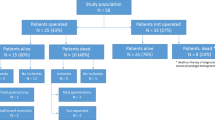Abstract
Background
Pneumatosis intestinalis (PI) and portal venous gas (PVG) historically mandated laparotomy due to the high mortality rate associated with mesenteric ischemia. Computed tomography (CT) can identify PI/PVG in patients with ischemic emergencies and benign idiopathic conditions.
Methods
A consecutive series of patients with PI or PVG was reviewed from a single institution over 5 years. Eighty-eight cases of PI/PVG were studied: 74 initial patients (year 1–4) were used to generate a treatment algorithm and fourteen additional cases were used to test the algorithm.
Results
PI and PVG were associated with three major clinical subgroups: mechanical causes (n = 29), acute mesenteric ischemia (n = 29), and benign idiopathic (n = 26); four were unclassifiable. Patients with acute mesenteric ischemia were associated with abdominal pain (p = 0.01), elevated lactate (≥3.0 mg/dL; p = 0.006), small bowel PI (p = 0.04), and calculated vascular disease score (p < 0.0005). The three subgroups could be distinguished using the generated algorithm with a sensitivity of 89%, specificity of 100%, and positive predictive value of 100%.
Conclusions
With greater sensitivity of modern CT scans, PI and PVG are being detected in patients with a wide range of surgical and non-surgical conditions. This clinical algorithm can identify subgroups to direct surgical intervention for acute ischemic insults and prevent non-therapeutic laparotomies for benign idiopathic PI and PVG.




Similar content being viewed by others
References
Ho LM, Paulson EK, Thompson WM. Pneumatosis intestinalis in the adult: benign to life-threatening causes. American Journal of Roentgenology 2007;188(6):1604–1613.
Hou SK, Chern CH, How CK, Chen JD, Wang LM, Lee CH. Hepatic portal venous gas: clinical significance of computed tomography findings. American Journal of Emergency Medicine 2004;22(3):214–218.
St. Peter SD, Abbas MA, Kelly KA. The spectrum of pneumatosis intestinalis. Archives of Surgery 2003;138(1):68–75.
Kinoshita H, Shinozaki M, Tanimura H, Umemoto Y, Sakaguchi S, Takifuji K, Kawasaki S, Hayashi H, Yamaue H. Clinical features and management of hepatic portal venous gas: four case reports and cumulative review of the literature. Archives of Surgery 2001;136(12):1410–1414.
Greenstein AJ, Nguyen SQ, Berlin A, Corona J, Lee J, Wong E, Factor SH, Divino CM. Pneumatosis intestinalis in adults: management, surgical indications, and risk factors for mortality. Journal of Gastrointestestinal Surgery 2007;11(10):1268–1274.
Feczko PJ, Mezwa DG, Farah MC, White BD. Clinical significance of pneumatosis of the bowel wall. Radiographics 1992;12(6):1069–1078.
Mclaughlin SA, Nguyen JH. Conservative management of nongangrenous esophageal and gastric pneumatosis. American Surgeon 2007;73(9):862–864.
Vanasin B, Wright JR, Schuster MM. Pneumatosis cystoides esophagi. Case report supporting theory of submucosal spread. Journal of the American Medical Association 1971;217(1):76–77.
Tixedor N, Taourel P, Adell JF, Bruel JM. Extensive esophageal pneumatosis after acute dilatation of the stomach. American Journal of Roentgenology 1998;171(1):272–273.
Zenooz NA, Robbin MR, Perez V. Gastric pneumatosis following nasogastric tube placement: a case report with literature review. Emergency Radiology 2007;13(4):205–207.
Rogy MA, Mirza DF, Kovats E, Rauhs R. Pneumatosis cystoides intestinalis (PCI). International Journal of Colorectal Diseases 1990;5(2):120–124.
Galandiuk S, Fazio VW. Pneumatosis cystoides intestinalis. A review of the literature. Diseases of the Colon and Rectum 1986;29(5):358–363.
Yale CE, Balish E. Pneumatosis cystoides intestinalis. Diseases of the Colon and Rectum 1976;19(2):107–111.
Sebastià C, Quiroga S, Espin E, Boyé R, Alvarez-Castells A, Armengol M. Portomesenteric vein gas: pathologic mechanisms, CT findings, and prognosis. Radiographics 2000;20(5):1213–224.
Chan SC, Wan YL, Cheung YC, Ng SH, Wong AM, Ng KK. Computed tomography findings in fatal cases of enormous hepatic portal venous gas. World Journal of Gastroenterology 2005;11(19):2953–2955.
University of Iowa Annual Report. http://www.uihealthcare.com/about/annualreport/0607/servicerecord.html (Accessed online 4/24/08).
Schindera ST, Triller J, Vock P, Hoppe H. Detection of hepatic portal venous gas: its clinical impact and outcome. Emergency Radiology 2006;12(4):164–170.
Monneuse O, Pilleul F, Barth X, Gruner L, Allaouchiche B, Valette PJ, Tissot E. Portal venous gas detected on computed tomography in emergency situations:surgery is still necessary. World Journal of Surgery 2007;31(5):1065–1071.
Morris MS, Gee AC, Cho SD, Limbaugh K, Underwood S, Ham B, Schreiber MA. Management and outcome of pneumatosis intestinalis. American Journal of Surgery 2008;195(5):679–682.
Iannitti DA, Gregg SC, Mayo-Smith WW, Tomolonis RJ, Cioffi WG, Pricolo VE. Portal venous gas detected by computed tomography: is surgery imperative? Digestive Surgery 2003;20(4):306–315.
Nelson, AL, Millington TM, Sahani D, Chung RT, Bauer C, Hertl M, Warshaw AL, Conrad C. Hepatic Prtal Venous Gas, The ABCs of Management. Archives of Surgery 2009;144(6):575–581.
Wiesner W, Mortelé KJ, Glickman JN, Ji H, Ros PR. Pneumatosis intestinalis and portomesenteric venous gas in intestinal ischemia:correlation of CT findings with severity of ischemia and clinical outcome. American Journal of Roentgenology 2001;177(6):1319–1323.
Liebman PR, Patten MT, Manny J, Benfield JR, Hechtman HB. Hepatic-portal venous gas in adults: etiology, pathophysiology and clinical significance. Annals of Surgery 1978;187(3):281–287.
Author information
Authors and Affiliations
Corresponding author
Additional information
This review was presented at The Society for Surgery of the Alimentary Tract Annual Meeting, June 2, 2009 Digestive Disease Week, Chicago, Illinois
Rights and permissions
About this article
Cite this article
Wayne, E., Ough, M., Wu, A. et al. Management Algorithm for Pneumatosis Intestinalis and Portal Venous Gas: Treatment and Outcome of 88 Consecutive Cases. J Gastrointest Surg 14, 437–448 (2010). https://doi.org/10.1007/s11605-009-1143-9
Received:
Accepted:
Published:
Issue Date:
DOI: https://doi.org/10.1007/s11605-009-1143-9




